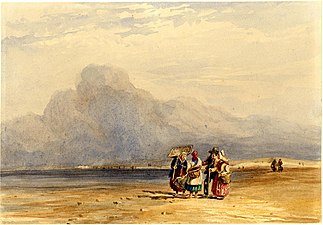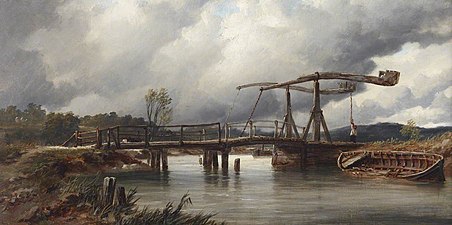Thomas Lound
Thomas Lound | |
|---|---|
 Self-portrait (undated) | |
| Born | 13 July 1801 |
| Died | 18 January 1861 (aged 59) Norwich |
| Nationality | British |
| Known for | Landscape painting |
| Movement | Norwich School of painters |
Thomas Lound (13 July 1801 – 18 January 1861) was an amateur English painter and etcher of landscapes, who specialised in depictions of his home county of Norfolk. He was a member of the Norwich School of painters, and lived in the city of Norwich all his life.
Born into a wealthy brewing family, Lound was affluent enough to possess his own photographic equipment as well as to pursue his passion for art. He become an avid collector of works of art, and particularly admired (and collected) the paintings of the Norwich painter John Thirtle. Lound was popular amongst his contemporaries, and close friends with the Norwich artists Robert Leman, Henry Bright and John Middleton. Throughout his life he suffered from ill health, and he died suddenly of apoplexy at the age of 59, a year after the deaths of his wife and son.
Lound is considered by
Life
Lound married Harriot Wetherill on Christmas Day 1821,
Popular amongst his peers,[4] Lound was a great friend of the amateur artist Robert Leman.[5][7] Together with Leman, the artists Henry Bright and John Middleton and Lound were all close friends.[8] Along with Leman and David Hodgson, Lound was a member of the Norwich Amateur Club; he and Hodgson helped to revitalise the Norwich Artists' Conversaziones.[9][note 1] He used his yacht Kathleen, which was adorned with a number of oil paintings, as a venue for entertaining his friends.[6] He is known to have travelled to Wales with Leman in 1851, and surviving sketchbooks show that he went to Wales and Yorkshire on sketching tours in 1845, 1853 and 1854.[12]
Lound was an avid collector of other artists' works, in particular those painted by the Norwich painter John Thirtle.[13] A great admirer of Thirtle, Lound used his wealth to acquire 75 of the artist's paintings.[6]
A keen photographer, Lound was wealthy enough to possess his own photographic equipment,[14] and was a committee member of the Norwich Photographic Society.[15] Little of his work as a photographer appears to have survived. He exhibited waxed-paper views of Ely Cathedral, Norwich fish market, and the ruins of Bromholm Priory.[4]
Lound's wife Harriot in 1859, and his son Henry Edwin Lound also predeceased him, dying in 1860.[16] Lound, who suffered from ill health all his life, died suddenly of apoplexy on 18 January 1861 whilst at his Norwich house in King Street.[17] His will was proved in February that year, with his two daughters Ellen and Harriot acting as executors.[18] His large art collection, which was sold the following month, included 39 sketches, 215 watercolours, 46 oil paintings, and 11 etchings.[5][19] Almost all the volumes from his library sold at auction after his death were art books.[20]
Artistic life
Training
Lound was one of a group of talented amateurs who learnt from the previous two generations of Norwich School artists.[21] He was a pupil of the artist John Sell Cotman, although his influence was not as great as that of the English landscape painter David Cox.[22][23] Lound became an accomplished draughtsman whose charcoal and chalk drawings resemble those by Joseph Stannard.[22]
Watercolours
Lound was a prolific
Writing in the 1980s, the art historian Andrew Moore has praised View of Norwich (Mill in Foreground) as "the most perfect example of Lound's original compositions".[2] Lound with Leman helped to form the Norfolk and Norwich Art Union, and was a while its president.[5] The art historian Derek Clifford describes his drawings as having "been done before by somebody else; so that every Lound is, as it were, a Thirtle or a Cotman or a Bright or a Cox".[23] Lound's works have at times been confused with those of Cotman, Crome, and Thirtle.[5] The Norwich Mercury praised his powers as an amateur artist.[16] According to Clifford, the "sometimes rather good" material contained in Lound's sketchbooks provides "a glimpse of the man himself".[23]
Lound exhibited 12 works with the Norwich Society of Artists from 1820 to 1833, first exhibiting his painting St Benet's Abbey.[25] He exhibited in London from 1845 to 1859, showing pictures at the British Institution and the Royal Academy of Arts.[5]
-
View of Norwich (undated), Norfolk Museums Collections
-
Ely Cathedral (undated), Norfolk Museums Collections
-
Shrimpers (after David Cox, undated), British Museum
-
Yarmouth Beach (undated), British Museum
-
The Keep and Gate, Ludlow Castle, Shropshire (undated, watercolour, gouache and graphite), Yale Center for British Art
-
Near Durham (undated), Norfolk Museums Collections
Etchings

Lound was a competent
Lound's 20 known etchings show the influence of drypoint technique of Edward Thomas Daniell, whose own etchings have a dark, rich quality.[28] Along with Henry Ninham, Lound began to adopt Daniell's technique after 1831.[29] His etchings—and those of Ninham and Miles Edmund Cotman—are very small in comparison with those produced by contemporaries such as Cotman, Daniell and Stannard.[13] They were not produced for public display, but were intended to be viewed closely by Lound's friends. After the mid-1830s Lound seems not to have etched any more, although he continued to paint and draw for another 30 years.[30]
Oils
Lound was influenced by Cotman in his style of oil painting. His oils contain both broad brush and fine brushwork, but according to Walpole, his oil paintings are less assured than his watercolours.[22]
-
A View near Norwich (c. 1850), Yale Center for British Art
-
St Benet's Abbey, Norfolk (undated), Norfolk Museums Collections
-
Yarmouth Beach and Jetty, after John Crome (undated), Norfolk Museums Collections
-
Marsh Mill near Reedham, Evening (undated)
-
A Swing Bridge on the River Ouse (undated), National Trust
Notes
- ^ The Artists' Conversaziones was inaugurated in 1829 and established by John Sell Cotman and John Berney Crome in 1830.. Membership was by subscription. The evening meetings, held regularly in the city's Norfolk Hotel, were aimed at promoting the fine arts in Norwich and included the inspection and discussion of works by artists present that evening. No further meetings were held after the demise of the Norwich Society of Artists in 1833.[10][11]
References
- ^ Thomas Lound in "Baptisms, burials and marriages 1718–1812 Beeston St. Andrew baptisms, burials and marriages 1761/2, 1795–1812", FamilySearch (Image 78). (registration required)
- ^ a b c Walpole 1997, p. 119.
- ^ "Marriage Notices". Bury and Norwich Post. 9 January 1822. p. 3. Retrieved 23 August 2021 – via British Newspaper Archive.
- ^ a b c d Taylor & Schaaf 2007, p. 342.
- ^ a b c d e f Moore 1985, p. 129.
- ^ a b c Dickes 1905, p. 576.
- ^ a b Walpole 1997, p. 116.
- ^ Walpole 1997, p. 133.
- ^ Walpole 1997, pp. 116–119.
- ^ Moore 1985, p. 118.
- ^ "The Cotman Collection". Leeds Museums and Galleries. 2019. Retrieved 3 September 2021.
- ^ Moore 1985, pp. 129, 134.
- ^ a b c Searle 2015, p. 71.
- ^ Moore 1985, p. 143.
- ^ "Norwich Photographic Society". Journal of the Photographic Society. 3: 310. 1857. Retrieved 10 March 2019.
- ^ a b c Moore 1985, p. 130.
- ^ Cust 1893, p. 153.
- ^ "Lound (1861)". Find a Will. gov.uk. Retrieved 23 August 2021.
- ^ Dickes 1905, p. 579.
- ^ Day 1969, p. 73.
- ^ Hemingway 1979, p. 8.
- ^ a b c Walpole 1997, p. 120.
- ^ a b c Clifford 1965, p. 49.
- ^ a b Walpole 1997, pp. 119–120.
- ^ Rajnai & Stevens 1976, pp. 68, 141.
- ^ Dickes 1905, pp. 575–576.
- ^ Moore 1985, pp. 24–25, 129.
- ^ Moore 1985, p. 109.
- ^ Searle 2015, p. 68.
- ^ Searle 2015, p. 72.
Bibliography
- Clifford, Derek Plint (1965). Watercolours of the Norwich School. London: Cory, Adams & Mackay. OCLC 1624701.
- Cust, Lionel Henry (1893). "Lound, Thomas". Dictionary of National Biography. London: Smith, Elder & Co.
- Day, Harold (1969). The Norwich School of Painters. Eastbourne, UK: Eastbourne Fine Art. ISBN 978-0-902010-10-9.
- OCLC 192940599.
- ISBN 978-0-7148-2001-9.
- Moore, Andrew (1985). The Norwich School of Artists. London: HMSO. ISBN 978-0-11-701587-6.
- Rajnai, Miklos; Stevens, Mary (1976). The Norwich Society of Artists, 1805–1833: a dictionary of contributors and their work. Norwich: Norfolk Museums Service for the Paul Mellon Centre for Studies in British Art. ISBN 978-0-903101-29-5.
- Searle, Geoffrey R. (2015). Etchings of the Norwich School. Norwich: Lasse Press. ISBN 978-0-95687-589-1.
- Taylor, Roger; Schaaf, John (2007). Impressed by Light: British Photographs from Paper Negatives, 1840-1860. New York: Metropolitan Museum of Art. ISBN 978-1-58839-225-1.
- Walpole, Josephine (1997). Art and Artists of the Norwich School. Woodbridge, UK: Antique Collectors' Club. ISBN 978-1-85149-261-9.
Further reading
- Norwich Castle Museum (1961). Centenary Exhibition of the Work of Thomas Lound (1802–1861). Norwich. )
- Pidgley, Michael (1974). Thomas Lound, 1802–1861: etchings and dry-points. A set of new impressions. London: C. Drake. OCLC 80633673.
External links
- Works by (or related to) Thomas Lound in the Norfolk Museums Collections
- Thomas Lound in Early Norfolk Photographs 1840–1860 by Norwich Heritage Projects
- History of Tompson's Brewery
- Works by Lound held at National Trust properties in the UK
- Lound's photograph of Norwich Fish Market (1856) from Picture Norfolk











